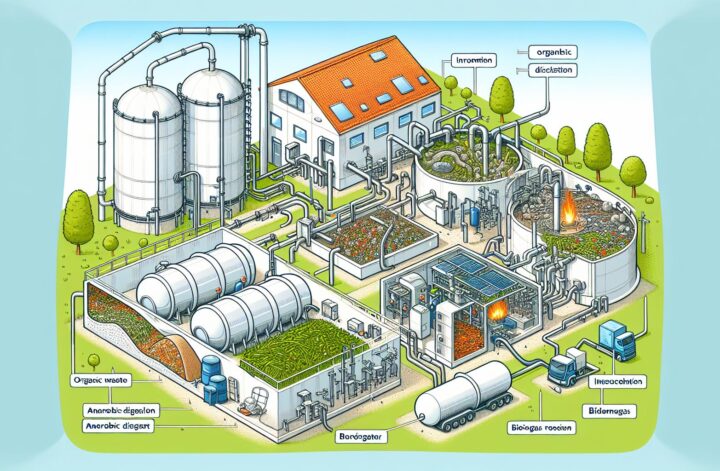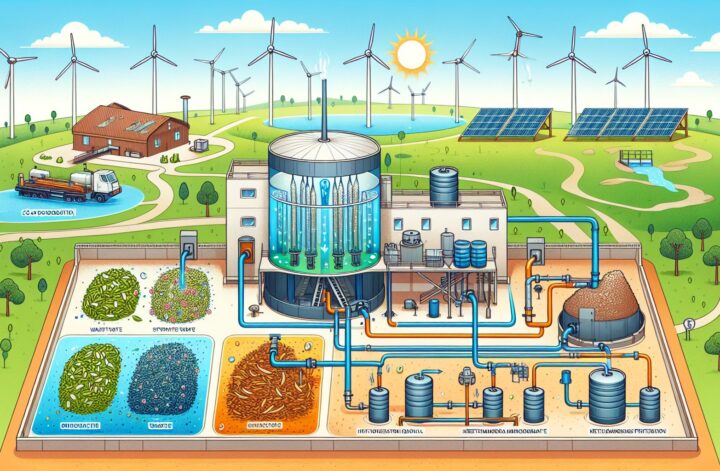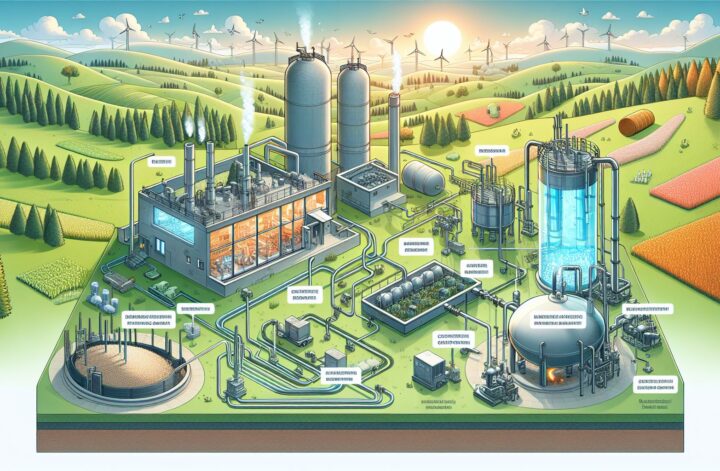Biogas production continues to make waves as a critical contributor to renewable energy development throughout the world. This remarkable energy source produced through the breakdown of organic waste significantly aids in the reduction of carbon emissions while fostering sustainable practices in energy production [^1^]. The goal of this article is to delve into the nitty-gritty of biogas production, highlighting its mechanism, benefits, challenges, and future prospects in the renewable energy world.
How is Biogas Produced?
Biogas production occurs by a process known as anaerobic digestion, a series of biological processes in which organic materials (biomass) are decomposed by microorganisms in an oxygen-free environment [^2^]. The result is the production of biogas containing methane (CH4), carbon dioxide (CO2), and traces of other gases such as hydrogen sulfide (H2S).
The process has four stages: hydrolysis, acidogenesis, acetogenesis, and methanogenesis. During hydrolysis, complex organic molecules are broken down into simpler sugars, amino acids, and fatty acids. Acidogenesis sees these products further transformed by acidogenic bacteria into volatile fatty acids, acetic acid, carbon dioxide, and hydrogen. Through acetogenesis, other bacteria convert these intermediary products into hydrogen, carbon dioxide, and acetate. Lastly, during methanogenesis, the methane-producing archaea transform acetate and carbon dioxide into methane [^2^].
The Significance of Biogas Production
The significance of biogas in the renewable energy landscape is dual fold: it provides an effective way to manage organic waste while simultaneously offering an alternative to fossil fuels in energy production [^1^]. The utilization of organic waste materials, including sewage sludge, animal manure, and food waste, in biogas production conveys an environmentally friendly solution to organic waste treatment.
Moreover, the production process results in digestate, a nutrient-rich matter that can replace chemical fertilizers in agriculture to further the benefits of agronomic and environmental resource efficiency [^3^].
Production of biogas immensely contributes to reducing greenhouse gas emissions by preventing the release of methane and nitrous oxide into the atmosphere, potent greenhouse gases involved in global warming. It also aids in reducing our dependence on fossil fuels by providing an alternative source of renewable energy through direct combustion or upgrading into biomethane, a substitute for natural gas [^1^].
The Challenges in Biogas Production
Despite its substantial potential, biogas production isn’t without challenges. Factors such as ammonia toxicity and sulfide toxicity can hinder the biogas production process by affecting the microbial communities involved in anaerobic digestion. High concentrations of ammonia reduce the methane yield by inhibiting the methanogenic archaea [^4^].
Another common issue associated with biogas production is the presence of contaminants in the biogas, most notably hydrogen sulfide, which is corrosive and harmful to human health and the environment [^5^]. To overcome this, biogas scrubbing is commonly applied to remove such impurities and adopt safe biogas use.
The Future of Biogas
The potential of biogas to confront our growing energy demand, mitigate climate change impacts, and foster sustainable development is unarguable. Further advancements in biogas production technology will allow the industry to overcome the present challenges and enhance the efficiency of the process.
The future lies in innovative biogas upgrading technologies that can harness higher quantities of methane from biogas, enhance the digestate’s quality for better utilization, and establish better control on the anaerobic digestion process. Furthermore, intelligent schemes for biogas utilization that could find ways for its better integration into existing energy infrastructures are necessary to unlock its full potential.
Given the current transition towards renewable energy, it is expected that biogas production will continue to gain increased focus in global efforts to achieve sustainable energy strategies while ensuring environmental conservation, making it a pillar in the energy landscape of the future [^3^].
Key advancements in biogas production technology and its adoption on a larger scale are pivotal in our pursuit of renewable energy, sustainable development, and climate change mitigation. And as we continue to develop and innovate in this sphere, one thing appears to be certain: biogas production has a pivotal role to play in the future of our planet.
[^1^]: Paul Scherrer Institut (PSI). “Biogas from waste.” Retrieved from https://www.psi.ch/en/ta/biogas-from-waste
[^2^]: Natural Resources Canada. “How is biogas produced?” Retrieved from https://www.nrcan.gc.ca/energy/renewable-electricity/bioenergy-resources/how-biogas-produced/7391
[^3^]: Bioenergy Association of New Zealand. “What is Biogas?” Retrieved from https://www.bioenergy.org.nz/biogas
[^4^]: Guibaud, G., Labatut, R.A., & Rogeau, D. “Inhibition of Anaerobic Digestion and Effect on Process Stability.” Retrieved from https://www.researchgate.net/publication/319663782_Inhibition_of_Anaerobic_Digestion_and_Effect_on_Process_Stability
[^5^]: Ramirez, I., Franco, C.A., & Rios, M.M. (2020). “Hydrogen Sulfide Removal in Biogas: A Review.” Catalysts, 10(5), 595. https://doi.org/10.3390/catal10050595
Please note that this article is intended for educational purposes and doesn’t constitute professional advice.




